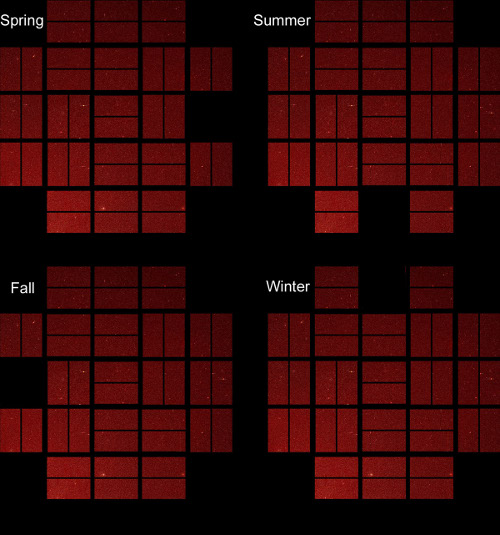Making discoveries with new space missions always seems frustratingly slow, probably because with missions like Kepler, our expectations are so high. So it’s interesting to ponder what all is involved in getting the data analyzed and the discoveries pegged. This post from the Kepler team’s Charlie Sobeck points out that the first five planets Kepler found were the result of six weeks of flight data and about 25 days of ground-based observing to eliminate the false positives and determine the mass of the planets and properties of the host stars.
Nothing runs as smoothly as we might wish. The Kepler team had to sort through much of the data manually because the data processing software is not yet fully functional at NASA Ames. But word from the site is that a major software upgrade has finished development and can now be applied to analysis of almost a full year of data. It’s also worth noting that the Kepler mission is now being managed by Ames rather than the Jet Propulsion Laboratory. Getting past that kind of management transition has got to be a spur for new results.
Sobeck does note a problem with one of the spacecraft’s detector modules, which stopped working on January 9:
Under normal operations, each module and its electronics convert light into digital numbers. For the darkest parts of the image between stars, we expect these numbers to be very small (but not zero). Correspondingly, for the brightest stars in the image, much larger numbers are expected creating an image of each observed star and its background neighborhood. The numbers we see coming out of failed module 3 are all very similar in size and considerably lower than the normal levels. These numbers produce an image that looks like the “snow” on a television that has very bad reception. There are no stars visible in these images.
The problematic module is on the periphery of the field of view, and because the spacecraft rotates by 90 degrees every three months, the problem should not compromise the mission — the module observes a different part of the Kepler field of view each season. You can see the module’s position (and the spacecraft’s rotation) in the following image:
Image: Kepler field of view showing position of the failed module for each season. Credit: Charlie Sobeck/Kepler science team.
The module may be recoverable, but several weeks will go by before the team makes the attempt as the current situation is reviewed. But even in the worst case scenario of total module failure, Sobeck points out that no part of the Kepler field of view is rendered unobservable by the problem. At worst, the reduction in results might reach 5 percent, a figure, he adds, that “…shouldn’t significantly affect the Kepler science performance.”




The Kepler team should have just finished the spring quarter roll and the March data download a few days ago.
Almost a year’s worth of data to analyse? That data may contain the first evidence of HZ terrestial planets around K-dwarfs.
It’s going to be a nail-biter about how the other CCD pair modules hold up
over time. Great work if they can get the failed one working again.
Too bad the mission has run less smoothly than initially anticipated, as it seems like there have been quite a few glitches so far.
So, after the soon-to-be completed review of one year’s worth of data, does this mean that Kepler has probably already discovered terrestrial planets in the HZs of M and K dwarf stars? Afterall, the ground-based Mearth survey which has not been underway for very long already found, in combination with follow-up RV measurements, a super-Earth around an M dwarf– surely the Kepler mission’s capabilities are superior to this ground-based survey, no?
Spaceman,
I think that the key here is the follow up required to verify candidate detections. This is done using bigger telescopes and radial velocity methods, all of which take time.
COROT has hundreds of leads but only 9 officially announced planets. They do not have as many resources specifically dedicated to verification as Kepler. On the other hand, being a better instrument, Kepler is probably collecting more candidates faster. In a few years time we should get some really interesting statistical information on extrasolar planets.
What I’d really like to know is how the various radial velocity searches around Alpha Centauri are coming up : it has been nearly a year since at least one of them started (Deborah Fisher’s). There are others but I don’t know when they started collecting data. Some hints could be there already.
Kepler will publish more discoveries shortly after it’s one year observational anniversary in late May. I’d expect a June and January cycle of 6 month releases ongoing. Jan 2011 is my expected timeframe for the first substantive data releases describing HZ planetary populations around early M stars. Three orbital sightings plus ground truth verification where possible; hard to do with Ms.
The whole process is going to be lots slower that folks like I had first assumed based on intitil Kepler hype, given data embargo for publishing and scarce ground telescope time.
I really hope they’ve gotten their stuff together with the much needed data filtering and analysis software and can save the laborious hand/eye data reduction effort.
I think the best that can be done for RV follow-up on earth mass planets at this time is to establish a minimum detectable mass floor.
If the host star is displaying a repeating transit-like light curve and RV spectroscopy is not detecting anything then large mass objects can be ruled out. Instead,depending on the quality of the RV data astronomers can calculate the maximum mass and smaller that would escape detection by the
RV observations.
This will have to serve until better detectors(like FINDS Exo-Earths) are up and running.
I’m unsure if earth mass planets orbiting HZ distance from a late sequence M-Dwarf could be confirmed by the RV method at this time.